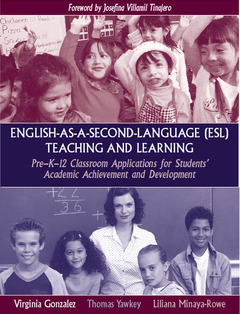Description
Esl teaching and learning
Authors: BRUSCA Rita-Vega, GONZALEZ Virginia, YAWKEY Thomas
Language: English
Approximative price 59.52 €
Subject to availability at the publisher.
Add to cart400 p. · Paperback
Description
/li>Contents
/li>
This long-awaited text provides the most current, high-quality pedagogical and assessment approaches and strategies that respond to current policy and high-stakes standards movement, and that can effectively increase academic achievement in at-risk English language learners.
This text is framed within a contemporary socio-constructivistic developmental view of teaching and learning in ESL education and from an integrationist perspective, offering an integration of most effective pedagogy for enhancing the quality of instruction and assessment in ESL students. Case examples are provided in boxes and text throughout chapters to help students apply concepts and learn problem-solving techniques through case studies.
Foundational Context of ESL Teaching and Learning: Thematic and Theoretical Perspectives, and Demographic and Policy Reality of ESL Students.
1. The Role of Immigrant ESL Students in the History of USEducation: Making a Personal Connection
2. Understanding the USDemographics and Policies of Language Diversity
3. From Theory to Practice with ESL and All Students
Part II. Best Assessment and Instructional Practices for ESL and All Students: How Can Teachers Stimulate Development and Academic Achievement in ESL and All Students in Their Classrooms.
4. A Contemporary View of Best Instructional Approaches for ESL and All Students.
5. A Bilingual Developmental Model and Curriculum for Increasing ESL and Mainstream Young Children's Development and Academic Achievement.
6. Increasing Academic Achievement and Language Acquisition for ESL Students across Grade Levels.
7. Assessing Learning and Academic Achievement in ESL Students for Instructional and Accountability Purposes.
8. Building a Comprehensive Assessment System of Language and Content Learning with Portfolios for ESL Students: Multiple Formats for Multiple Perspectives.
9. Integrating Technology for Assessing and Instructing ESL Students.
10. Teaching as Mentoring: ESL Teachers as Mediators between ESL Students, Their Families, and the School System.
11. Conclusions: A Dialogue about Myths Held by Educators and Recommendations for Better Educational Practices for ESL Students.
Author Biographical Sketch.
Index.




